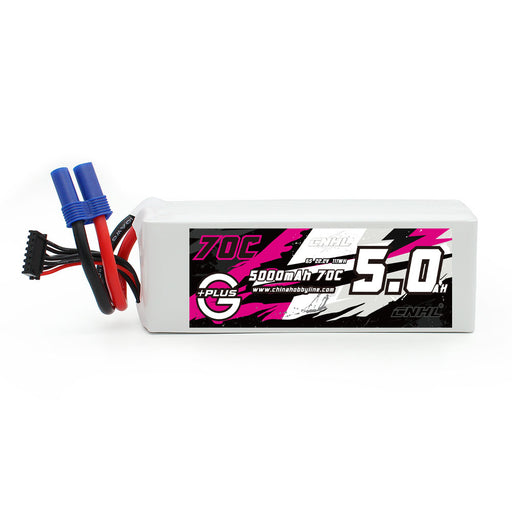
6S LiPo 배터리의 “건강 코드” 해독: 수명 연장과 상태 모니터링을 위한 실용 기술
처음에는 강력했지만 금세 힘을 잃거나 베개처럼 부풀어 오른 6S LiPo 배터리를 경험한 적 있나요? RC 세계에서 흔한 불만입니다. 이들은 일반 AA 배터리와 다릅니다; LiPo는 강력하지만 민감합니다. 기대 수명에 못 미치는 경우는 거의 단 한 번의 극적인 사건 때문이 아닙니다. 대부분은 충전, 방전, 사용, 보관 과정에서의 작은 실수들이 누적된 결과입니다. 이러한 요인을 이해하는 것이 투자한 배터리에서 더 많은 사이클과 안정적인 출력을 얻는 첫걸음입니다.
6S 리튬 폴리머 배터리 수명에 영향을 미치는 7가지 핵심 요인
여러 가지 요인이 6S LiPo 배터리 수명을 단축시킬 수 있습니다. 배터리 성능이 저하될 때 흔히 문제를 일으키는 원인들로 생각하세요.
1. 과충전 및 과방전: 가장 흔한 "킬러"
이것이 가장 큰 적입니다. LiPo 셀을 최대 허용 전압(일반적으로 6S의 경우 셀당 4.2V, 총 25.2V)을 초과하여 충전하면 되돌릴 수 없는 손상이 발생해 부풀거나 화재가 날 수 있습니다. 마찬가지로 셀을 최소 안전 전압(보통 셀당 약 3.0V~3.2V, 6S의 경우 부하 시 18.0V~19.2V) 이하로 방전하면 용량과 수명이 영구적으로 감소할 수 있습니다. 이 경계는 절대 넘지 말아야 할 한계입니다.
2. 부적절한 보관 전압 및 기간
배터리를 최적의 충전 및 보관 방법으로 관리할 때 기억하세요: 6S LiPo 배터리를 완전히 충전된 상태로 장기간(며칠 또는 몇 주) 방치하면 셀에 스트레스를 주고 노화를 가속화합니다. 반대로 완전히 방전된 상태로 보관하는 것도 해롭습니다. 셀당 약 3.8V~3.85V의 "보관 전압" 적정 구간이 존재하는 데는 이유가 있습니다.
3. 극한 온도에서의 사용 및 보관
LiPo 배터리는 극한의 열과 추위를 싫어합니다. 너무 뜨거운 상태(예: 140°F/60°C 이상)나 너무 추운 상태(얼음에 가까운 온도)에서 충전하거나 방전하면 배터리가 손상될 수 있습니다. 열은 주요 적으로, 화학 반응을 가속화하여 배터리를 악화시킵니다.
4. 물리적 손상
이건 꽤 명백합니다. 배터리를 떨어뜨리거나 케이스를 찌르는 것(절대 금지!), 심지어 압착하는 것도 내부 단락, 손상 및 잠재적으로 위험한 상황을 초래할 수 있습니다. 항상 조심해서 다루세요.

5. 과도한 충전 전류
모든 6S LiPo 배터리는 보통 'C' 등급(예: 1C, 2C)으로 표시된 최대 권장 충전 속도가 있습니다. 권장보다 높은 전류(예: 5000mAh 팩을 1C/5암페어로 충전해야 하는데 10암페어로 충전 시)로 충전하면 과도한 열이 발생하고 셀에 스트레스를 줍니다.
6. 고강도 연속 방전 및 불충분한 열 방출
배터리를 절대 한계까지 장시간 사용하면서 식힐 시간을 주지 않으면 내부 열이 많이 발생합니다. 만약 배터리에 충분한 공기 흐름이 없다면 이 열이 쌓여 배터리를 내부부터 손상시킵니다. 이는 고속 레이싱이나 공격적인 3D 비행에서 흔히 발생합니다.
7. 불균형 배터리 셀
6S LiPo 배터리는 직렬로 연결된 6개의 개별 셀로 구성됩니다. 이상적으로는 모든 셀이 동일한 전압을 가져야 합니다. 하나 이상의 셀이 다른 셀보다 현저히 낮거나 높으면(불균형) 충전 및 방전 시 전체 팩에 스트레스를 주어 약한 셀의 조기 고장을 초래합니다.
"유지보수" 우선: 6S LiPo 배터리 수명을 연장하는 일상 작업
좋은 소식입니다! 많은 '치명적 문제'는 기본적인 일상 관리만으로도 예방할 수 있습니다. 이를 좋은 배터리 위생이라고 생각하세요.
과도한 충전 전류를 피하기 위해 반드시 밸런스 충전을 사용하세요
항상 품질 좋은 LiPo 충전기를 사용하고, 밸런스 충전 모드를 지원하는 충전기를 매번 사용하세요. 이렇게 하면 6개의 셀 각각이 동일한 전압으로 충전됩니다. 제조사가 권장하는 충전 전류(보통 1C, 별도 명시가 없는 한)를 준수하세요. 서두르지 마세요.
저전압 보호/알람 설정 및 신뢰
대부분의 최신 ESC(전자 속도 제어기)는 프로그래밍 가능한 저전압 차단(LVC)을 갖추고 있습니다. 이를 안전한 수준(예: 부하 상태에서 셀당 3.2V~3.4V)으로 설정하세요. 또는 전압이 너무 낮아지면 경고음을 내는 LiPo 전압 알람을 사용하세요. 그 임계값에 도달했을 때 착륙하거나 멈추는 것이 매우 중요합니다.
저장 전압에 올바르게 맞추고 적절한 환경을 선택하세요
6S LiPo 배터리를 하루 이틀 내에 사용하지 않을 경우, 저장 전압(셀당 약 3.80-3.85V)으로 방전하거나 충전하세요. 배터리는 서늘하고 건조한 곳에 보관하며, 이상적으로는 LiPo 안전 가방이나 탄약통에 보관하세요.

장기간 극한 출력은 피하고, 비행/주행 후 배터리 냉각에 주의하세요
배터리를 사용 시간 내내 최대 C-등급으로 작동하지 않도록 하세요. 가능하면 휴식을 주고, 강한 사용 후에는 충전하기 전에 배터리를 주변 온도까지 식히세요. 따뜻한 배터리는 스트레스를 받은 배터리입니다.
외관이 부풀거나 손상되었는지 관찰하고, 커넥터가 단단한지 확인하세요
사용 전후에 배터리를 빠르게 시각적으로 점검하세요. 부풀음, 움푹 들어간 곳, 래퍼나 전선의 손상 징후가 있는지 확인하고, 커넥터가 깨끗하고 단단한지 확인하세요.
배터리 건강 모니터링: "예리한 눈"을 가진 플레이어가 되세요
일상적인 관리 외에도 배터리 건강을 적극적으로 모니터링하면 문제의 조기 경고를 받을 수 있습니다.
전압 감지:
간단한 LiPo 전압 검사기/셀 검사기는 필수 도구입니다. 사용 후 및 충전 전에는 6S LiPo 배터리의 전체 전압과 더 중요한 각 개별 셀의 전압을 확인하세요.
가장 높은 셀과 가장 낮은 셀 간의 전압 차이에 주의하세요. 균형 충전 후 또는 사용 중에 0.05V에서 0.1V 이상의 차이가 있으면 하나 이상의 셀에 문제가 있을 수 있습니다. 지속적으로 큰 차이가 나타나면 셀이 약해지고 있다는 신호입니다.
내부 저항(IR) 측정:
내부 저항은 LiPo 배터리의 건강과 전류 공급 능력을 나타내는 주요 지표입니다. 일반적으로 낮은 IR이 더 좋습니다. 배터리가 노화되고 열화됨에 따라 IR이 증가합니다.
많은 최신 LiPo 충전기는 각 셀의 내부 저항(IR)을 측정할 수 있습니다. 배터리가 새로울 때 IR을 확인하고 기록을 유지하세요. 시간이 지남에 따라 IR이 크게 증가하거나 한 셀의 IR이 다른 셀보다 훨씬 높으면 건강 상태가 악화되고 있음을 나타냅니다.
용량 감소 인식:
노후된 6S LiPo 배터리에서 가장 눈에 띄는 징후 중 하나는 사용 시간이 줄어드는 것입니다. 완전 충전 후 비행이나 주행 시간이 눈에 띄게 짧아진다면 배터리의 실제 용량이 감소하고 있을 가능성이 큽니다.
일부 스마트 충전기는 방전 사이클을 수행하여 배터리의 현재 실제 용량(mAh)을 추정할 수 있습니다. 이를 정격 용량과 비교하면 많은 정보를 알 수 있습니다.
외관 검사:
약간의 영구적인 부풀음이나 배터리 하드 케이스(있는 경우) 또는 소프트 팩의 변형도 경고 신호입니다. 부풀음은 셀 내부 가스 축적으로 인해 발생하며, 이는 과방전, 과열 또는 일반적인 열화 때문입니다.
배터리 수명 주기 기록:
직접적인 건강 지표는 아니지만 각 6S LiPo 배터리가 거친 충전/방전 사이클 수를 대략 파악하면 일반적인 서비스 수명 종료 시기를 예측하는 데 도움이 됩니다. 일부 사람들은 배터리에 라벨을 붙이고 사이클을 기록하기도 합니다. 또한 배터리 충전 및 방전 관련 매개변수를 이해하여 배터리를 더 잘 충전하고 방전해야 합니다.
"오래된" 배터리를 판단하고 처리하는 4가지 방법
결국, 가장 잘 관리된 6S LiPo 배터리도 수명이 다합니다. 언제 퇴역시켜야 하는지 아는 것은 성능과 안전에 중요합니다.
1. 성능이 크게 저하됨(용량, 방전 능력)
사용 시간이 급격히 짧아지거나 배터리가 예전처럼 충분한 전류(암페어)를 공급하지 못하고 심한 전압 강하가 발생하면 노후가 진행 중임을 나타냅니다.
2. 내부 저항이 너무 높고 전압 차이가 너무 큼
내부 저항(IR) 값이 새것일 때보다 지속적으로 훨씬 높거나 셀 밸런스가 제대로 맞지 않아(큰 전압 차이가 지속) 배터리가 문제를 겪고 있습니다.
3. 명백한 부풀음 또는 물리적 손상
심각하거나 영구적인 부풀음, 또는 움푹 들어가거나 포장지가 찢어지는 등 물리적 손상이 있으면 배터리가 손상된 것입니다.
4. 배터리를 "퇴역"시키고 안전하게 폐기해야 할 때
명확한 규칙은 없지만 이러한 징후가 조합되어 보이면 교체할 때입니다. 배터리 고장으로 모델(또는 안전)을 위험에 빠뜨리지 마세요. LiPo를 폐기하려면 완전히 방전시키세요(예: 전구 방전기를 사용해 셀당 0V까지) 그리고 배터리 재활용 시설에 가져가거나 지역 유해 폐기물 처리 지침을 따르세요. 일부 취미 상점에서도 오래된 LiPo를 받습니다. LiPo를 펑크 내어 방전시키지 마세요.
결론: 오래가는 전원을 위해 신중하게 관리하세요
귀하의 6S LiPo 배터리는 적절한 관리가 필요한 고성능 부품입니다. 수명에 영향을 미치는 요인을 이해하고 올바른 충전, 사용, 보관 및 모니터링 습관을 실천함으로써 배터리 수명을 크게 연장하고 비용을 절감하며 모든 RC 모험에 신뢰할 수 있는 전원을 확보할 수 있습니다. 잘 관리하면 더 많은 흥미진진한 비행과 주행으로 보답할 것입니다!


베스트 셀러즈
-
원래 가격 $65.99원래 가격 $65.99 - 원래 가격 $65.99원래 가격 $65.99$53.99 USD - $65.99 USD$53.99 - $65.99현재 가격 $53.99 USD
CNHL G+Plus 5000mAh 22.2V 6S 리포 배터리 70C EC5 플러그 포함
재고 10+개 이상 있습니다사양: 재고 번호: 500706EC5 용량: 5000mAh 전압: 22.2V / 6-셀 / 6S1P 방전율: 70C 연속 / 140C 순간 충전율: 최대 5C 크기(1-5mm 차이): 49X51X149mm(높이*너비*길이) 대략 무게(±5g) : 714g 출...
전체 세부 정보 보기원래 가격 $65.99원래 가격 $65.99 - 원래 가격 $65.99원래 가격 $65.99$53.99 USD - $65.99 USD$53.99 - $65.99현재 가격 $53.99 USD최대 18% 절약하세요 -
원래 가격 $38.99원래 가격 $38.99 - 원래 가격 $38.99원래 가격 $38.99$34.99 USD - $38.99 USD$34.99 - $38.99현재 가격 $34.99 USD
CNHL 스피디 피자 시리즈 프로 1350mAh 22.2V 6S 150C 리포 배터리 XT60 플러그 포함
재고 10+개 이상 있습니다사양: 재고 번호: 1351506PZ 용량: 1350mAh 전압: 22.2V / 6셀 / 6S1P 방전 속도: 연속 150C / 순간 300C 충전 속도: 최대 5C 크기(1-5mm 차이): 38X38X78mm 대략 무게(±5g) : 215g 출력 커넥터: X...
전체 세부 정보 보기원래 가격 $38.99원래 가격 $38.99 - 원래 가격 $38.99원래 가격 $38.99$34.99 USD - $38.99 USD$34.99 - $38.99현재 가격 $34.99 USD최대 10% 절약하세요 -
원래 가격 $51.98원래 가격 $51.98 - 원래 가격 $51.98원래 가격 $51.98$46.78 USD - $51.98 USD$46.78 - $51.98현재 가격 $46.78 USD
2팩 CNHL 블랙 시리즈 V2.0 1300mAh 22.2V 6S 130C 리포 배터리 XT60 플러그 포함
재고 10+개 이상 있습니다사양 재고 번호: 1301306BK 용량: 1300mAh 전압: 22.2V / 6-셀 / 6S1P 방전율: 130C 연속 / 260C 순간 충전율: 최대 5C 크기(1-5mm 차이): 48X33X77mm 대략 무게(±5g) : 210g 출력 커넥터: XT60 밸...
전체 세부 정보 보기원래 가격 $51.98원래 가격 $51.98 - 원래 가격 $51.98원래 가격 $51.98$46.78 USD - $51.98 USD$46.78 - $51.98현재 가격 $46.78 USD최대 10% 절약하세요 -
원래 가격 $43.98원래 가격 $43.98 - 원래 가격 $43.98원래 가격 $43.98$31.98 USD - $43.98 USD$31.98 - $43.98현재 가격 $31.98 USD
[Combo] 2팩 CNHL MiniStar 1500mAh 14.8V 4S Lipo 배터리 120C XT60 플러그 포함
재고 10+개 이상 있습니다사양: 재고 번호: 1501204 용량: 1500mAh 전압: 14.8V / 4셀 / 4S1P 방전 속도: 연속 120C / 순간 240C 충전 속도: 최대 5C 크기(1-5mm 차이): 37X33X76mm 대략 무게(±5g) : 169g 출력 커넥터: XT60...
전체 세부 정보 보기원래 가격 $43.98원래 가격 $43.98 - 원래 가격 $43.98원래 가격 $43.98$31.98 USD - $43.98 USD$31.98 - $43.98현재 가격 $31.98 USD최대 27% 절약하세요 -
원래 가격 $23.98 - 원래 가격 $37.98원래 가격 $23.98 - 원래 가격 $37.98원래 가격 $23.98$19.98 USD - $37.98 USD$19.98 - $37.98현재 가격 $19.98 USD
2팩 CNHL 블랙 시리즈 2200mAh 3S 11.1V 30C 리포 배터리 XT60 플러그 포함
재고 10+개 이상 있습니다사양: 재고 번호: 220303BK 용량: 2200mAh 전압: 11.1V / 3셀 / 3S1P 방전율: 30C 연속 / 60C 버스트 충전 속도: 최대 5C 크기(1-5mm 차이): 24X34X106mm 대략 무게(±5g) : 180g 출력 커넥터: XT60 ...
전체 세부 정보 보기원래 가격 $23.98 - 원래 가격 $37.98원래 가격 $23.98 - 원래 가격 $37.98원래 가격 $23.98$19.98 USD - $37.98 USD$19.98 - $37.98현재 가격 $19.98 USD최대 17% 절약하세요
새 항목
-
원래 가격 $119.99 - 원래 가격 $119.99원래 가격 $119.99$119.99 USD$119.99 - $119.99현재 가격 $119.99 USD
VOLANTEX 스핏파이어 RC 비행기 4채널 6축 자이로 안정화 탑재 즉시 비행 가능
단 9 개만 남았습니다제2차 세계대전의 전설적인 영국 전투기에서 영감을 받은 VOLANTEX 스핏파이어 RC 비행기는 고전적인 전투기 외관과 현대적인 초보자 친화적 비행 제어를 결합했습니다. VOLANTEX의 검증된 400mm 플랫폼을 기반으로 제작된 이 즉시 비행 가능한 RC...
전체 세부 정보 보기원래 가격 $119.99 - 원래 가격 $119.99원래 가격 $119.99$119.99 USD$119.99 - $119.99현재 가격 $119.99 USD -
원래 가격 $122.99 - 원래 가격 $122.99원래 가격 $122.99$122.99 USD$122.99 - $122.99현재 가격 $122.99 USD
VOLANTEX BF109 RC 비행기 4채널 RTF – 자이로 및 XPilot 탑재 제2차 세계대전 전투기
단 9 개만 남았습니다VOLANTEX BF109 4채널 RC 비행기 RTF는 가장 상징적인 제2차 세계대전 전투기 중 하나를 컴팩트하고 초보자 친화적인 패키지로 선보입니다. 400mm 날개폭, 가벼운 EPP 폼 기체, 그리고 XPilot 자이로 시스템을 갖춘 이 전투기는 새로운 ...
전체 세부 정보 보기원래 가격 $122.99 - 원래 가격 $122.99원래 가격 $122.99$122.99 USD$122.99 - $122.99현재 가격 $122.99 USD -
원래 가격 $117.99 - 원래 가격 $117.99원래 가격 $117.99$117.99 USD$117.99 - $117.99현재 가격 $117.99 USD
Volantex RC 비행기 P51D V2 400mm RTF – 초보자를 위한 XPilot 안정장치가 탑재된 4채널 워버드
단 9 개만 남았습니다Volantex RC 비행기 P51D V2 RTF는 학습을 최대한 편안하게 할 수 있도록 설계된 컴팩트한 WWII 스타일 전투기입니다. 400mm 날개 길이, EPP 폼 구조, XPilot 6축 안정화 장치를 갖춘 이 Volantex RC 비행기는 초보자에게 ...
전체 세부 정보 보기원래 가격 $117.99 - 원래 가격 $117.99원래 가격 $117.99$117.99 USD$117.99 - $117.99현재 가격 $117.99 USD -
원래 가격 $148.87 - 원래 가격 $148.87원래 가격 $148.87$148.87 USD$148.87 - $148.87현재 가격 $148.87 USD
MF-A84 690mm P-47 스타일 브러시리스 RC 비행기 (RTF, 카메라 없음)
단 9 개만 남았습니다MF-A84 690mm 브러시리스 RC 비행기는 P-47 썬더볼트와 Ki-84 같은 클래식 전투기에서 영감을 받은 전투기 스타일 모델입니다. 강력한 브러시리스 모터, 3단계 자이로 시스템, EPP 내구성, 최대 25분 비행 시간으로 초보자와 숙련된 조종사 모...
전체 세부 정보 보기원래 가격 $148.87 - 원래 가격 $148.87원래 가격 $148.87$148.87 USD$148.87 - $148.87현재 가격 $148.87 USD -
원래 가격 $95.99 - 원래 가격 $95.99원래 가격 $95.99$95.99 USD$95.99 - $95.99현재 가격 $95.99 USD
CNHL G+Plus 6000mAh 22.2V 6S 100C 리포 배터리 EC5 플러그 포함
재고 10+개 이상 있습니다사양: 재고 번호: 6001006EC5 용량: 6000mAh 전압: 22.2V / 6-셀 / 6S1P 방전율: 100C 연속 / 200C 순간 충전율: 최대 5C 크기(1-5mm 차이): 40X66X170mm(높이*너비*길이) 대략 무게(±5g) : 975g...
전체 세부 정보 보기원래 가격 $95.99 - 원래 가격 $95.99원래 가격 $95.99$95.99 USD$95.99 - $95.99현재 가격 $95.99 USD





















댓글 남기기